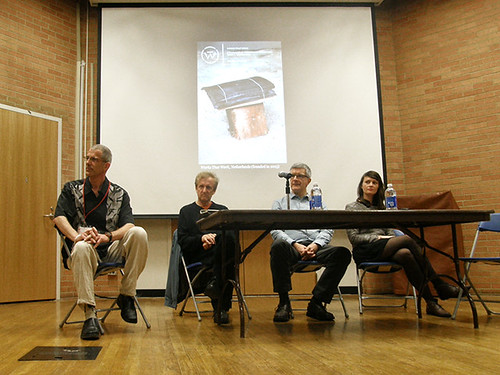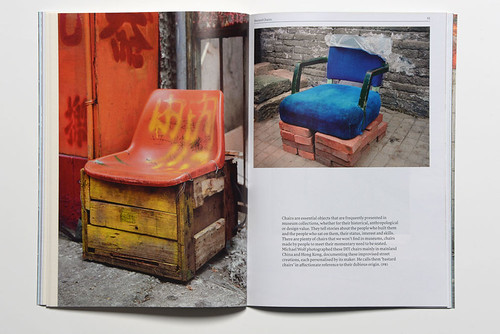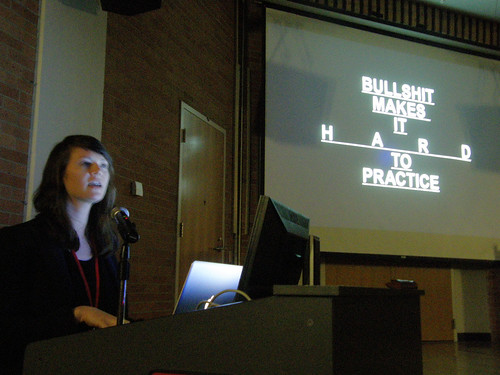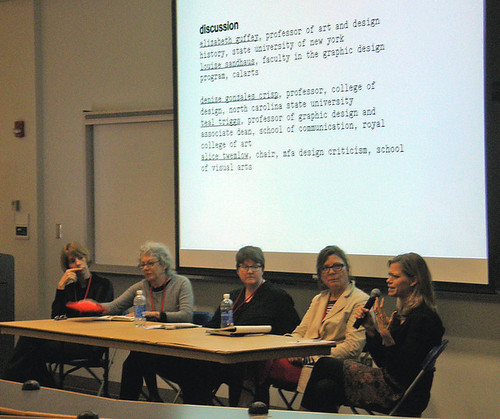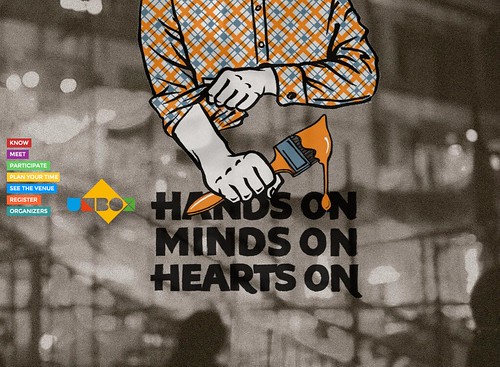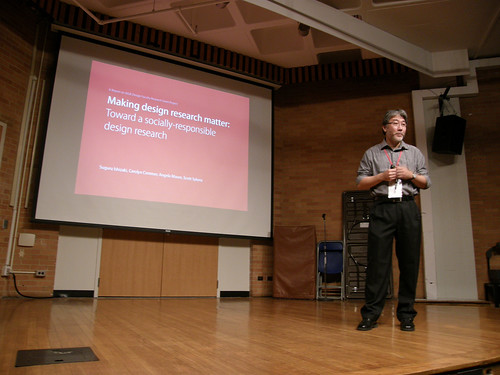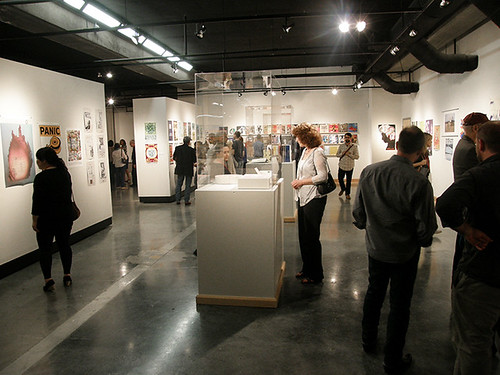Friday, 5:26pm
10 May 2013
Critical mass
Blunt, a conference in Virginia, explored the state of design criticism with academics, designers and writers
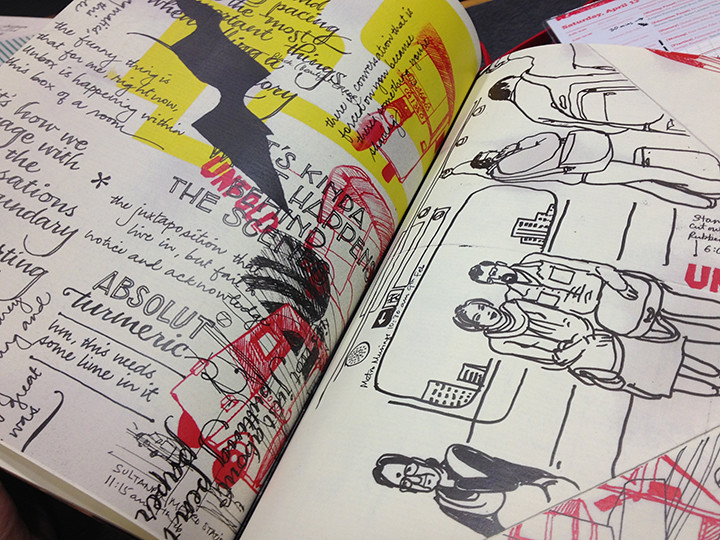
Design criticism, the act of reflecting on and evaluating design work, has not kept pace with the rapidly expanding field of professional practice. Some say we are experiencing a dearth of critical discourse, writes Aggie Toppins. Others say that criticism is out there but you have to know where to look.
At ‘Blunt: Explicit and Graphic Design Criticism Now’ at Old Dominion University in Norfolk, Virginia, designers, educators, and writers debated topics related to criticism within and surrounding the field of graphic design.
Conference co-organiser Kenneth FitzGerald moderated a panel discussion with (L to R) David Stairs, Rick Poynor and Michèle Champagne.
Top: spread from a publication made by ZinePress.
Rick Poynor began the event with his keynote ‘What Does Design Criticism Want? (And Who Wants Design Criticism?)’. He called for designers to write regularly and in quantity if we want to attract the general public to design issues. In the panel that followed his talk, Poynor said, ‘Intellectual capital comes from a critical mass.’
Poynor also talked about new spaces for asserting criticism: niche publications, such as Peter Bil’ak’s recent magazine Works that Work, small publishing houses such as Occasional Papers in the UK, and sites for cultural activity such as Prem Krishmamurthy’s P! gallery in New York. These forums are opportunities for intellectual engagement even if the audience is limited.
Spread from Peter Bil’ak’s Works that Work.
Poynor’s talk sparked a wave of conversation about how the Web has affected design dialogue. The space once used for critical exchange has become overrun by inspiration sites where visitors go to consume images of trendy projects – a new breed of design blogs offers little to no writing to contextualise the work. Thoughtful critique has waned in favour of effusive praise.
Those design blogs are the fuel that fires Michèle Champagne’s blog and publication That New Design Smell. ‘Criticism isn’t an ideal we reach for anymore’, said Champagne, who started her project out of a desire to disagree. Champagne challenged the culture of ‘niceness’ in design writing, which she called ‘the likedy like mafia’. In a panel discussion with Poynor and David Stairs – founder of Designers Without Borders and editor of The Design Altruism Project – Champagne talked about the shallowness of ‘excessive optimism’.
‘A desire to disagree.’ Michèle Champagne.
In a presentation called ‘Design Criticism: How to Write it’, Ellen Lupton offered a structure for writing about design. ‘True criticism is an act of honouring the content you’re studying.’ Lupton offered a formal analysis of graphic framing devices, including examples ranging from the common ‘New Look! Same Great Product!’ starbursts found on consumer packaging to Emigre’s Historia catalogue. (See ‘California panorama’ in Eye 77.)
Lupton showed that even the most debased design strategy can have redeeming qualities. A strong writer can bring out those qualities for readers. Lupton offered a tip to make design writing interesting, approachable, and relevant perhaps even to non-designers: ‘Tell readers something in a way that makes them feel like they already knew it.’
A panel with (L to R) Elizabeth Guffey, Louise Sandhaus, Teal Triggs, Denise Gonzales Crisp, Alice Twemlow
Teal Triggs spoke about design as a cultural event in her panel discussion, ‘Zine from Afar: Design Writing in India’. Triggs asked, ‘What happens when fanzines are used to engage community-based change?’ She shared her experience working with ZinePress, a live publishing team that explored collaborative content making at the UnBox Festival, an annual celebration of interdisciplinary thought and work in New Delhi. The ZinePress team wrote, designed, and published a critical volume about UnBox as the event was happening, allowing happenings at the festival to be documented and distributed as printed matter.
The UnBox Festival in New Delhi experimented with collaborative design writing and documentation via ZinePress.
Triggs’s interest in community engagement was echoed in a panel by John Jennings, Associate Professor of Visual Studies at State University of New York Buffalo, and Eric Benson, Associate Professor of Graphic Design at the University of Illinois at Urbana-Champaign. In ‘DeZombies and the Coming Apocalypse’, Jennings and Benson talked about the need to educate designers to take responsible roles in society. They used the zombie metaphor to describe ‘the type of design student we’re putting out into the world and what the repercussions are’, said Jennings. He and Benson argued that schools fail to adequately prepare students when they produce vocationally savvy but critically impoverished designers. ‘We shouldn’t train our students to beg for corporate jobs’, said Benson. Instead, we should prepare them to be critical designers who recognise the impact of their work on the environment and on culture.
At the end of the second day of the conference, David Stairs gave a talk about design activism. He spoke critically about altruism as a methodology — a methodology involving no such buzzwords as ‘interventions’, ‘thought leadership’, or ‘change-making’. Many reputable design organisations have famously discussed ‘designing for the other 90 percent’ or even ‘designing with the other 90 percent’. The former tasks the first world to develop solutions for third world problems such as contaminated water, or famine. The latter implies adding a layer of cultural sensitivity to the design process. Stairs expressed dissatisfaction with both of these models and asked the audience at Blunt to consider what it would mean to ‘design by the other 90 percent’, – to allow third world cultures to educate the first world.
AIGA Researcher Suguru Ishizaki discussed socially responsible design research.
Participants at Blunt pushed for that investigation through more doctoral and masters programmes in design writing, more peer-reviewed academic journals, more critical journalism, more published independent design experiments, and more useful theory represented on blogs. But who will read this? What will they do with it?
As the field of graphic design expands its reach, we continually struggle to define it. Teal Triggs quoted social scientist Laurel Richardson: ‘Writing is a way of knowing’. By writing about design, we will know our field better.
Graphic design is changing. It will continue to melt at the edges into many other fields but at the core there are theories and concepts that distinguish graphic design as a discipline. To amplify design criticism – whether in writing, in education, or in practice – is to substantiate our field as it matures.
Attendees visited ‘Mount’, a two-part exhibition that featured the letterpress posters of Hatch Show Print and graphic design artifacts from the personal collection of conference co-organiser Kenneth FitzGerald.
Blunt: Explicit and Graphic Design Criticism Now took place at Old Dominion University, Norfok, Virginia, USA, 12-14 April 2013.
Aggie Toppins is a graphic designer and assistant professor of graphic design at the University of Tennessee at Chattanooga.
Eye is the world’s most beautiful and collectable graphic design journal, published quarterly for professional designers, students and anyone interested in critical, informed writing about graphic design and visual culture. It is available from all good design bookshops and online at the Eye shop, where you can buy subscriptions, back issues and single copies of the latest issue. You can see what Eye 84 looks like at Eye before You Buy on Vimeo.

